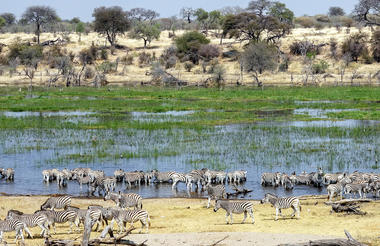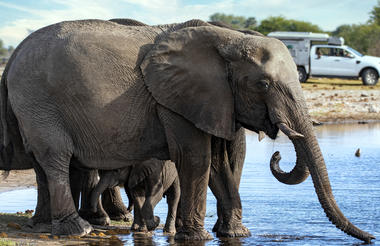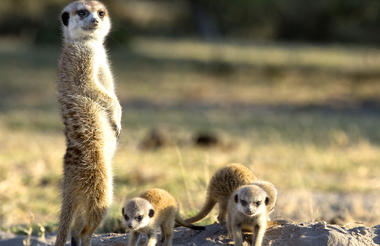At Victoria Falls, the earth splits open and swallows one of Africa’s greatest rivers, the mighty Zambezi, creating the largest sheet of falling water on earth. As the water hits the narrow depths of the Batoka Gorge beneath, it blasts a cloud of mist skywards, lending the falls their local name ‘mosi-oa-tunya’ (the smoke that thunders). When the Zambezi is its fullest, the mist hangs a permanent raincloud above the falls, showering visitors on even the sunniest of days and visible for miles around.
Above the falls on the upper Zambezi, boats cruise the tranquil water at sunset while the distant spray catches the fading light downstream. Below the falls, the Batoka Gorge’s rocky walls funnel the lower Zambezi into a chain of world-class rapids, prime for white water rafting.
Aside from being a UNESCO world heritage site and a natural world wonder, Victoria Falls also forms a natural border between Zimbabwe and Zambia. The falls can be seen from both countries, and for the most part the same activities are offered on both sides, from helicopter scenic flights to village visits and souvenir shopping.
Whether your idea of getting away from it all is a relaxed high tea in colonial grandeur or a heart-stopping bungee jump off a bridge, Victoria Falls keeps both the faint of heart and the most insatiable of adrenalin junkies busy for days.
From Zambia, a side on view of the falls is on offer with views into the Batoka Gorge, as well as the possibility of perching yourself at the edge of the falls on the vertigo-inducing Livingstone Island.
From Zimbabwe, you’ll get a full-frontal view of three quarters of the falls’ 1.7km wide curtain of water from viewpoints and footpaths meandering through a rainforest kept hot and humid by the spray of the falls.
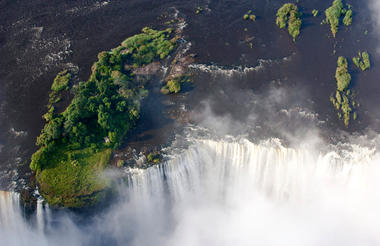
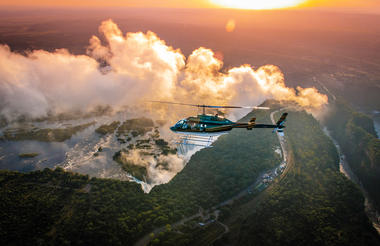
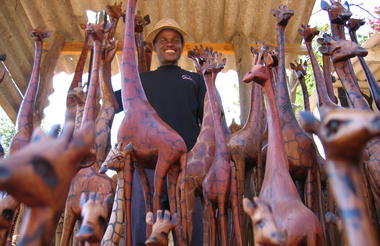
The Chobe River Front is a remarkable wildlife area due to the permanent water source of the Chobe River. However its accessibility from Kasane and neighbouring towns of Victoria Falls and Livingstone has created quite a busy tourist area with larger hotels and lodges than you find in the more remote Okavango Delta. The spectacle of all the animals coming to drink and frolic at the water's edge is one to behold, particularly in the dry season (May - Oct) where water is scarce away from the river. It is an area famous for its abundance of elephants, a variety of predators and, in addition, you are likely to see herds of buffalo and possibly even roan and sable antelope. In the rainy season (Nov - Apr) the game is much less concentrated at the river as the wildlife spread throughout the greater area of Chobe National Park due to availability of surface water from nearby pans. This assists the vegetation on the river banks in recovering from the massive herds that are attracted to the area in the dry months. The summer rains bring beautiful wild flowers, exquisite scenery, impressive bird life and an abundance of young animals usually born around November/December. The spectacular Chobe sunsets alone are worth a visit to the area. Please note that activities are restricted within the national park in accordance with government rules and regulations: these include no driving off-road, no walking and no driving after dark.
Chobe Game Lodge is the only lodge situated within the National Park. The remainder of the lodges, hotels and guesthouses in the Chobe area are located along the river in the town of Kasane, adjacent to the park. In addition there are some lodges situated further out of Kasane and in the Chobe Forestry Reserve, namely Muchenje Safari Lodge and Elephant Valley Lodge for those looking for something in more of a bush setting.
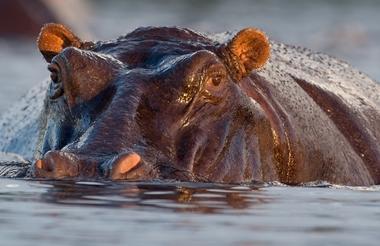


When it comes to Botswana, Savute breaks all the rules: both for animal behaviour and for habitats. Here, lions hunt elephants, leopards take to fishing, the grasslands are vast and open and rocky hills punctuate the flat terrain.
Savute has proved itself somewhat of an enigma over the decades. During years of abundance its marsh fills with water, fed by the Savute Channel. The water weaves its way here from Angola via a chain of rivers and lagoons, spilling out into the marsh and drawing huge herds of elephants, wildebeest, zebras and buffalos.
In drier years, the channel shrinks into small pools and can evaporate completely, leaving the marsh dry and sending wildlife to the waterholes for water, where the tension between plains game and predators heats up over a parched and dusty landscape.
Wherever the plains game goes in Savute, the predators follow close-by, learning tricks of survival to adapt to the marsh’s ever changing nature. Whether the water flows here or not is anyone’s guess. The channel and marsh have a life of their own, independent both of the seasons and the annual rainfall.
Savute doesn’t just offer a safari; it’s also a feast for the eyes. Whitewashed skeletal trees set against green grass and huge blue skies, blinding red sunsets that spill purple and orange across the bush, and endless horizons that fade into a hazy mirage with the heat.
As Savute is part of Chobe National Park, a safari here is limited to game drives only. With the diversity of habitats, wildlife and landscapes that the marsh has to offer however, you’ll still find yourself wishing you had more time to see it all.

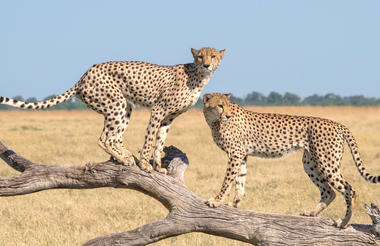
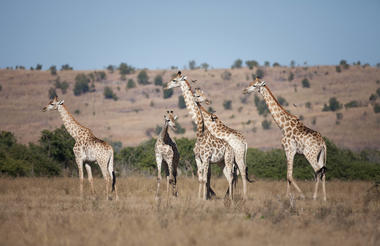
The Moremi Game Reserve is all about searching for big game; where the habitats are as diverse as the wildlife itself. Water-adapted antelopes and wary-eyed buffaloes spill out into floodplains, behind towering woodlands where leopards hide on the high branches. Dead trees cast silhouettes over elephant-filled savannas a stone’s throw from papyrus-fringed channels stretching out to the delta beyond.
When you arrive in the Moremi Game Reserve, it’s anyone’s guess what you’ll find lurking in the long grass. From wild dogs stalking waterbucks to long sunsets by a hippo-filled lagoon, the scenes will live on in memory long after the journey home.
Kick up sharp smelling clouds of dust on a morning drive, disturbing pockets of warm air in the reeds as you splash through water crossings in pursuit of a distant lion’s call. Pause by the edge of large lagoons, squinting to catch mischief making hyenas as they emerge from the trees to drink.
When you get sick of game drives, discover the channels by boat while Squacco herons fly alongside you into the wind. Watch a lazy sunset with the blue-cheeked bee eaters before returning to dry land for more hardcore bush exploration.
As Moremi Game Reserve is bound by national park rules, activities here are limited to game drives during hours of daylight with no off-roading, and boat cruises on the permanent channels.
While most of the reserve is open to the public, two private lodges sit in the Mombo Concession to the north of Chief’s Island, surrounded by the waters of the Okavango Delta. Boating isn’t possible here, instead the area offers the ultimate in dry-land game viewing. Hailed as Botswana’s predator capital, this exclusive corner is closed to outsiders and home to the big five, where the invitee list fills up years in advance.



The Makgadikgadi National Park is where the Okavango Delta finally fades into desert. The Boteti River draws a line in the sand, separating the dry Makgadikgadi from the thirst lands of the Kalahari beyond. This is the ultimate last chance for hundreds of zebras and wildebeest that crowd the water’s edge to quench a desert-drawn thirst.
The Boteti is the last finger of the Okavango Delta, reaching down to the Makgadikgadi Salt Pans. Years have passed without the river being fed a drop at all; becoming a long sandy riverbed with shrinking waterholes, where zebras jostle for space under high-flying sheets of dust. At other times, the Boteti swells up fat and full, spilling into saltpans hundreds of kilometers from its source before evaporating into thin air.
This is the place to watch plains game crashing through sharp acacia trees, gathering under lofty palms and lurking in the shade of the riverine woodland, keeping close to the water. When the Boteti River is full, big elephant bulls can often be found playing in the water and browsing in the reeds while the sun sets on the day.
Although the park’s eastern edges touch the Makgadikgadi saltpans, its unlikely you’ll see them during your stay. Where the saltpans are about landscapes, the Boteti is about a more traditional safari experience. Explore the banks by game drive, drift along the river by boat (when water levels allow), or wait for the wildlife to pass by from the sanctuary of a hide.
Once the rains arrive (October – November) the zebras and wildebeest abandon the Boteti, migrating to the saltpans and only returning in the winter (April – May). During the green season the Boteti’s banks become a quiet green landscape of technicolour sunsets and an explosion of birdlife.
